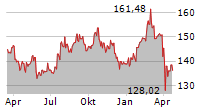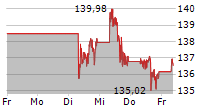
Building on decades of the Company's Alzheimer's research, two differentiated investigational therapies aim to slow pathological tau in distinct populations
Fast Track designations reinforce J&J's commitment to Alzheimer's disease development and the potential of its precision approach
TITUSVILLE, N.J., Jan. 8, 2025 /PRNewswire/ -- Johnson & Johnson (NYSE: JNJ) announced today that the U.S. Food and Drug Administration (FDA) has granted Fast Track designation to posdinemab, a phosphorylated tau-directed monoclonal antibody (mAb) being investigated to treat patients with early Alzheimer's disease (AD) in the Phase 2b "AuTonomy" study. The internally discovered mAb has shown the potential in targeting disease-associated phosphorylated tau in cerebrospinal fluid (CSF) from treated AD patients, and in blocking the development and spread of tau aggregates in non-clinical models of disease.
"As the average age of the global population increases, the number of people impacted by this debilitating progressive disease continues to rise. Alzheimer's disease places a substantial emotional and financial burden on patients and their loved ones and has a significant economic and societal impact. At J&J, we envision a future where we can help stop the progression of AD the moment it's detected," said Bill Martin, Ph.D., Global Therapeutic Area Head, Neuroscience, Johnson & Johnson Innovative Medicine. "Posdinemab has the potential to slow the spread of tau pathology in the brain - which may slow cognitive decline. The FDA's Fast Track designation reflects the urgent unmet need for new treatment options for the millions living with AD."
Posdinemab is the second Fast Track designation granted in 2024 for the Company's AD portfolio. J&J's anti-tau active immunotherapy, JNJ-2056, the first active immunotherapy targeting tau in a preclinical AD population, was also granted Fast Track designation in July 2024. The Phase 2b "ReTain" trial, which is actively enrolling, will evaluate the potential of JNJ-2056 to activate the immune system to help generate antibodies against pathological phosphorylated tau, with the goal of delaying or preventing onset of symptoms, and ultimately disease progression.
Fast Track is a process designed by the FDA to expedite the review of therapies that treat serious conditions with a high unmet need, with the aim of getting therapies to patients earlier.
Globally, 55 million people live with dementia, with AD accounting for 60-80 percent of cases.1 AD is a neurodegenerative disorder marked by progressive memory loss and other cognitive decline that disrupts daily life, leaving patients requiring around-the-clock care and ultimately, leading to death.
ABOUT ALZHEIMER'S DISEASE & DEMENTIA
Alzheimer's disease (AD), the most common form of dementia worldwide, is a fatal neurodegenerative disorder characterized by progressive memory loss and a decline in other cognitive abilities severe enough to significantly interfere with daily life.1 Diagnostic criteria for AD are based on established classifications but continue to evolve as research advances. Preclinical AD refers to individuals with detectable Alzheimer's disease pathology (amyloid and tau) who are cognitively unimpaired. Early Alzheimer's disease includes individuals with mild cognitive impairment due to Alzheimer's disease (also known as prodromal AD) and mild Alzheimer's dementia.
As AD advances, patients experience worsening cognitive decline, eventually losing the ability to perform basic tasks, communicate or recognize loved ones, ultimately leading to death.1 There is no cure for AD, and despite several new advancements, significant unmet need remains across the spectrum of this devastating disease.
ABOUT POSDINEMAB
Posdinemab is an investigational monoclonal antibody that targets the mid-domain of Alzheimer's disease-specific phosphorylated tau. Posdinemab is designed to bind to pathological phosphorylated tau when it is released from neurons and neutralize it before it can seed/spread to another neuron. The internally-discovered compound has shown promise in reducing tau seeding-the process by which toxic tau spreads through the brain-in both in vitro and in vivo non-clinical studies.
The Phase 2b "AuTonomy" study investigating posdinemab in participants with early Alzheimer's disease is fully enrolled and ongoing (NCT04619420).
ABOUT JNJ-2056
JNJ-2056 (formerly known as ACI-35.030, in collaboration with AC Immune) is an investigational anti-tau active immunotherapy targeting the c-terminal region of pathological phosphorylated tau. It is designed to inhibit the seeding and spreading of pathological tau, with the goal of delaying or preventing the onset of clinical symptoms in preclinical Alzheimer's disease (AD).
The Phase 2b "ReTain" study is evaluating JNJ-2056 in participants with preclinical AD who have tau pathology in their brains but have not yet developed cognitive impairment. The trial is actively enrolling and will be the first active immunotherapy targeting tau tested in a preclinical AD population (NCT06544616).
ABOUT JOHNSON & JOHNSON
At Johnson & Johnson, we believe health is everything. Our strength in healthcare innovation empowers us to build a world where complex diseases are prevented, treated, and cured, where treatments are smarter and less invasive, and where solutions are personal. Through our expertise in Innovative Medicine and MedTech, we are uniquely positioned to innovate across the full spectrum of healthcare solutions today to deliver the breakthroughs of tomorrow and profoundly impact health for humanity.
Learn more at https://www.jnj.com/ or at www.innovativemedicine.jnj.com.
Follow us at @JanssenUS and @JNJInnovMed.
Janssen Research & Development, LLC is a Johnson & Johnson company.
CAUTIONS CONCERNING FORWARD-LOOKING STATEMENTS
This press release contains "forward-looking statements" as defined in the Private Securities Litigation Reform Act of 1995 regarding product development and the potential benefits and treatment impact of posdinemab and JNJ-2056. The reader is cautioned not to rely on these forward-looking statements. These statements are based on current expectations of future events. If underlying assumptions prove inaccurate or known or unknown risks or uncertainties materialize, actual results could vary materially from the expectations and projections of Janssen Research & Development, LLC and/or Johnson & Johnson. Risks and uncertainties include, but are not limited to: challenges and uncertainties inherent in product research and development, including the uncertainty of clinical success and of obtaining regulatory approvals; uncertainty of commercial success; manufacturing difficulties and delays; competition, including technological advances, new products, and patents attained by competitors; challenges to patents; product efficacy or safety concerns resulting in product recalls or regulatory action; changes in behavior and spending patterns of purchasers of healthcare products and services; changes to applicable laws and regulations, including global healthcare reforms; and trends toward healthcare cost containment. A further list and descriptions of these risks, uncertainties, and other factors can be found in Johnson & Johnson's Annual Report on Form 10-K for the fiscal year ended December 31, 2023, including in the sections captioned "Cautionary Note Regarding Forward-Looking Statements" and "Item 1A. Risk Factors," and in Johnson & Johnson's subsequent Quarterly Reports on Form 10-Q and other filings with the U.S. Securities and Exchange Commission. Copies of these filings are available online at www.sec.gov, www.jnj.com, or on request from Johnson & Johnson. Janssen Research & Development, LLC nor Johnson & Johnson undertakes to update any forward-looking statement as a result of new information or future events or developments.
© Johnson & Johnson 2025. All rights reserved.
Media contact:
Allie Prull
[email protected]
Investor contact:
Lauren Johnson
[email protected]
- Alzheimer's Association. 2024 Alzheimer's Disease Facts and Figures. Accessed August 2024. https://www.alz.org/media/documents/alzheimers-facts-and-figures.pdf
SOURCE Johnson & Johnson





